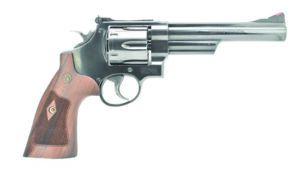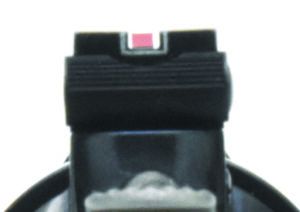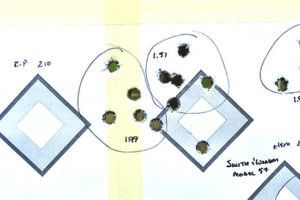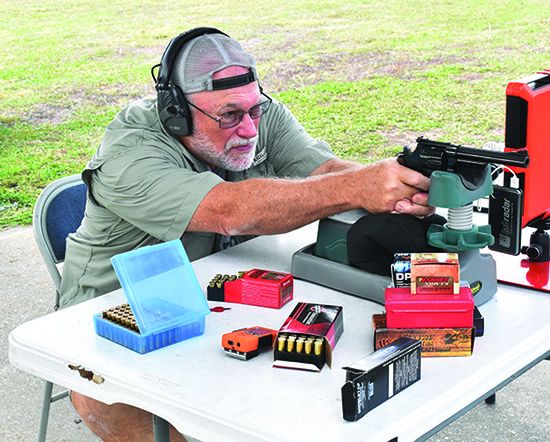Considering our readers’ interest in the 10mm cartridge in recent years, we weren’t too surprised to receive a request to cover the 41 Remington Magnum. With a tad more energy than the 10mm, the 41 Magnum essentially occupies the same space in the energy rankings as its 40-bore brother, but it does so in a rimmed case more suitable for a revolver. But while the 10mm has recovered from its “can’t get no respect” status, the 41 Magnum still suffers from mediocre sales, and we’re not sure why.
Perhaps one of the reasons for the lackadaisical sales is the dearth of firearms chambered in a true .410-diameter bullet. As of this writing, Smith & Wesson is the only company that still catalogs revolvers chambered in 41 Magnum. But that’s OK — they invented the chambering, and they know more than a little about it. In fact, Smith & Wesson invented all three of the earliest magnum chamberings and a new class of revolvers to go with them.
We decided to visit with the latest version of these classic cartridges. Wanting to stay true to the early magnum-capable platforms, we secured three S&W “N” Frame revolvers chambered in 357 Magnum (Model 27), 44 Magnum (Model 29), and 41 Magnum (Model 57). All three of our test guns have 6-inch (or longer) barrels. All three have good, adjustable sights. All three are heavy enough to dampen recoil from the magnum cartridges. All three have top straps that have been tapped and drilled for a scope mount. But could they shoot well enough to earn the moniker of a hunting handgun? We had to find out.
Our first test piece was the 357 Magnum Model 27-9 with the 6.5-inch barrel, Model No. 150341, $1189. Our 44 Magnum Model 29-10 sample was also a 6.5-inch barrel model, and it included a wood presentation case in Model No. 150145, $1309. Then, of course, we looked at the revolver that started this quest, a Model 57-6 chambered in 41 Magnum Model No. 150481, $979. Here’s how they performed at the range.
Smith & Wesson Model 57-6 No. 150481 41 Remington Magnum
$979
GUN TESTS GRADE: B+
With 5% to 10% less energy in the most common loadings while generating 20% less felt recoil than the 44 Magnum, the 41 Magnum is a cartridge that does not remotely receive the credit it is due. For the revolver enthusiast who also likes the 10mm concept, this may be your baby.

| Action Type | Revolver |
| Overall Length | 11.4 in. |
| Overall Height | 6.25 in. |
| Maximum Width | 1.712 in. |
| Weight Unloaded | 3.0 lbs. |
| Weight Loaded | 3.28 lbs. |
| Receiver Material | Blued carbon steel |
| Front Strap Height | 2.6 in. |
| Back Strap Height | 4.9 in. |
| Barrel Length | 6.0 in. |
| Grip Thickness Maximum | 1.428 in. |
| Grip Circumference | 5.25 in. |
| Rear Sight | Adjustable white outline |
| Front Sight | Red insert ramp |
| Sight Radius | 7.9 in. |
| Trigger Pull Weight Single Action 4.5 lbs. | |
| Trigger Pull Weight Double Action 11.8 lbs. | |
| Trigger Span | 3.25 in. |
| Safety | Manual lock |
| Warranty | Lifetime service policy |
| Telephone | (800) 331-0852 |
| Website | Smith-Wesson.com |
| Made In | USA |
The 41 Magnum is an anomaly in the cartridge world in that it really is a 41 caliber. The 38 Special is only 0.357 inch in diameter, and the 44 Magnum is only 0.4295 inch. Early pistol-cartridge designs had the driving bands and lubrication outside of the shell case. Imagine a modern 22 LR enlarged to 44 caliber, and you’ll get a great idea of what the early cartridge was like. Easy to produce, but dirt collected on the bullet enough to be a problem. In the 1870s, Russia was in dire need of pistols and made a deal with Smith & Wesson for break-top revolvers. They also didn’t like the driving bands outside the case and required that S&W design a new cartridge that corrected the issue. Named the 44 Russian, the forward portion of the bullet was now the same diameter as the heel inside the case. S&W settled on a diameter of 0.429-0.430 inch, and that has stuck with us to this day.

By the early 1960s, various firearms experts, notably Bill Jordan, Elmer Keith, and Skeeter Skelton, had decided that the 44 Magnum was too powerful for the average officer to use as an everyday duty weapon. They also noted that a steady diet of full power 357 Magnum cartridges could beat up the K Frame revolvers pretty badly. That has since been fixed but, at that time, those folks thought the perfect compromise was another N Frame revolver chambered in an intermediate cartridge. Their proposed solution was a true 0.410-inch-caliber round with two different loadings. The first was to be a 210-grain bullet moving right at 1300 fps, and the second was to be a 200-grain semi-wadcutter load at a more sedate 900 fps. But the “more power” era had already begun, and the actual production load was much closer to 1500 fps than 1300, while the “light police” load cranked out about 1150 fps. Add all that extra power to a revolver a good bit heavier than most were willing to carry, and the 41 Magnum just never caught on. Pity.

We put the 41 Magnum in the same category as the 10mm Auto. It has enough energy to get most jobs done on a par with the 44 Mag. For example, a 210-grain JHP exiting the muzzle at 1300 fps generates almost 800 foot-pounds of energy. A common load for the 44 Magnum is a 240-grain JHP at 1250 fps. At a calculated 823 foot-pounds, energy generated is not quite 50 foot-pounds more than the 41 Mag. We know this is subjective, but all of our testers said that the 41 Magnum had less felt recoil than the 44 — consensus seems to be in the 25% to 30% range — an opinion shared by almost every 41 Magnum aficionado we’ve discussed the phenomenon with over the years.
We found parts fitting on all three revolvers to be very good. Side plates lined up properly and the slot for the rear sight was crisp and square. Cuts on the barrel lined up with the same cuts on the frame. Cylinder lock-up was tight, and timing was perfect.
We noticed three differences between the Model 29 and the Model 57 that we should mention. The first and most obvious was the barrel length. The 41 Magnum has a 6-inch barrel, and the 44 Magnum sports a 6.5-inch tube. With the outside diameter of the barrels and cylinders the same thickness, the Model 57 ends up with thicker barrel and cylinder walls by virtue of the smaller hole. The net effect is a mere 0.3 ounce difference in weight, with the 41 Magnum being the lighter piece — barely.
S&W did us one more favor with the new models versus the old. Our 50-year-old Model 29 has a gorgeous set of cocobolo grips with nice color and grain. They are also too large for almost every hand we’ve ever seen. The new grips look to be black walnut with nice grain visible and have been reshaped. The base on the new model is narrower. We took several measurements for circumference at different places on the grip. In each case the new Model 57 was smaller than our older N Frame. The result is a revolver that is easier to hold with normal-sized hands.
The 210-grain HSM load at 900 fps qualifies as a 41 Special and was a joy to shoot, especially after shooting the 320-grain 44 Magnums. Our initial reaction to the 41 load was “Popgun!” while the round still generating almost 400 foot-pounds of energy. Groups were substantially less than 2 inches for five shots at 15 yards. Felt recoil was negligible. This reminds us that magnum chamberings do not have to be loaded to their hottest potential to be effective. That said, the full house 41s were within 6% of the energy of the standard load 44s — again with substantially less felt recoil. Groups were better than the same pistol chambered in 44 Magnum and split times on rapid-fire shots were a good bit less, another indication of a much more controllable load. Overall, the speed runs with the Model 57 showed a reduction of almost 27% for the timed length of the total run. Split times were almost 40% shorter than the M29.
Our Team Said: We won’t try to talk you into buying a Model 57-6 chambered in 41 Magnum. The cartridge and this model of Smith handgun seem to be hanging on by a thread. But this was a very good combination. Perhaps you can help the 41 Magnum have a resurgence along the lines of the 10mm Auto.
| 357 Magnum, 41 Magnum, and 44 Magnum Range Data | |||
| Smith & Wesson Cor-Bon DPX Model 27 357 Magnum | Cor-Bon DPX 125-grain JHP | Winchester 158-grain JSP | Doubletap 200-grain Hardcast |
| Average Velocity | 1236 fps | 1154 fps | 1284 fps |
| Muzzle Energy | 424 ft.-lbs. | 467 ft.-lbs. | 733 ft.-lbs. |
| Average Group Size | 1.75 in. | 1.67 in. | 1.93 in. |
| Best Group Size | 1.47 in. | 1.39 in. | 1.71 in. |
| Smith & Wesson Model 57 41 Magnum | Barnes 180-grain Vortex | HSM 210-grain SWC | Remington 210-grain JSP |
| Average Velocity | 1381 fps | 904 fps | 1294 fps |
| Muzzle Energy | 762 ft.-lbs. | 381 lbs. | 781 ft.-lbs. |
| Average Group Size | 2.31 in. | 1.69 in. | 1.83 in. |
| Best Group Size | 1.65 in. | 1.51 in. | 1.63 in. |
| Smith & Wesson Model 29 44 Magnum | Hornady 200-grain Flex | Black Hills 240-grain JHP | Doubletap 320-grain Hardcast |
| Average Velocity | 1407 fps | 1247 fps | 1343 fps |
| Muzzle Energy | 879 ft.-lbs. | 829 ft.-lbs. | 1282 ft.-lbs. |
| Average Group Size | 2.77 in. | 1.71 in. | 3.45 in. |
| Best Group Size | 1.83 in. | 1.47 in. | 2.35 in. |
All shooting was done at American Shooting Centers (AmericanShootingCenters.com) in Houston. Accuracy was tested at 15 yards by shooting multiple five-shot groups from a well-sandbagged Caldwell Pistolero shooting rest (MidwayUSA.com 517357, $2) assisted by a Mini DRC Fortune Cookie from Wiebad.com ($75, MINIFC). We chose a variety of ammo types and weights for each cartridge by using the Ammoseek.com search feature. In 357 Magnum, we found Cor-bon DPX 125-grain solid-copper bullets, Winchester SuperX 158-grain JSPs, and Doubletap 200-grain hard cast rounds. The 41 Remington Magnum selection included Barnes VOR-TX 180-grain XPB cartridges, HSM 210-grain Cowboy Loads, and Remington’s 210-grain XTP hollow point. The 44 Remington Magnum fodder also covered the weight and power spectrum with Hornady 200-grain MFX, Black Hills 240-grain JHP, and Doubletap 320-grain hard-cast bullets.
| DRILL DATA | |||
| Pistol | 1st Shot | Split Average | Total Time |
| Model 27 | 0.933 | 0.382 | 1.697 |
| Model 29 | 1.217 | 0.772 | 2.760 |
| Model 57 | 1.08 | 0.468 | 2.017 |
Process: Fire three shots from low ready at a USPSA target at 8 yards. Numbers are averages for three repetitions. Times are in seconds.
Written and photographed by Joe Woolley, using evaluations from Gun Tests Team members. GT




























